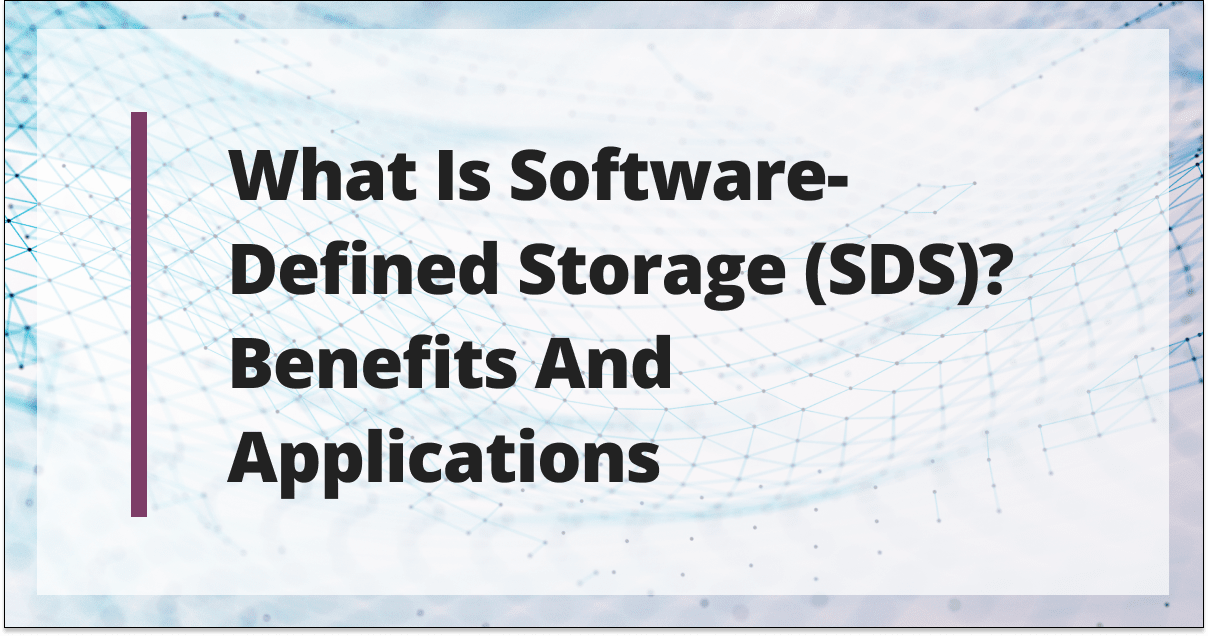
[ad_1]
In today’s world, data has become a valuable asset for organizations of all sizes, and managing this data efficiently is critical for their success. Explore the advantages of software-defined storage (SDS), from reduced cost to increased scalability. Also, learn how to use SDS in your organization’s cloud storage, data backup & recovery, and virtualization solutions.
What Is Software-Defined Storage (SDS)?
Software-defined storage is a type of data storage architecture that intentionally separates the control and management of data from the physical hardware that stores it. This means you can manage and allocate storage resources through software rather than relying on proprietary hardware. SDS abstracts the underlying storage infrastructure, allowing you to pool, allocate, and manage resources using industry-standard x86 servers, removing the dependence on proprietary hardware and vendor lock-in.
Software-defined storage is part of hyper-converged infrastructure, meaning software-defined anything is separated from the hardware it’s lying on, putting much more freedom and flexibility in your hands.
Benefits of SDS
Software-defined storage offers several benefits to organizations, mainly by allowing you to expand your storage capacity when and how you want to instead of scrambling to add another piece of proprietary hardware.
Increased Agility
Software-defined storage allows faster adaptation to changing storage needs. When it comes to scaling up traditional storage architecture, options are limited, slow, and costly. Because the storage software is decoupled from hardware, you can choose how to scale based on your current needs.
One great example of such agility is that SDS can pool various sources such as external disks, flash drives, virtual private servers (VPS), containers, virtual machines (VMs), storage-area network (SAN), network-attached storage (NAS), or other cloud-based resources, regardless of how fast or slow the devices are, into a single virtual pool.
Lower Cost
You can make significant cost reductions with SDS due to better storage infrastructure usage. For instance, a RAID driver that aims to back up data can only work with a certain amount of drives. A new RAID system would have to include the cost of new cases, disks, and RAID controllers. Additionally, you will still need the software to connect the two separate RAID drives. But with software-defined storage, the software controls how these drives are handled.
Since it’s hardware-agnostic and something like a commodity or x86 server from different vendors can be combined, the ability to use existing hardware means it is less expensive than supplier lock-in through proprietary hardware options.
Increased Scalability
Scalability is another area where software-defined storage has significant advantages. Because of the ability to combine commodity and existing hardware from any vendor without limitations, the result is superior scalability with virtually infinite possible storage nodes.
Applications of SDS
Cloud Storage
SDS is particularly well-suited for cloud storage environments and can help manage and scale storage resources across cloud types. You can simplify data management and reduce costs by implementing SDS in your cloud storage infrastructure.
The ability to pool resources from multiple devices allows you to create a highly available and resilient storage system that can support a wide range of workloads. SDS also enables organizations to manage cloud storage resources more quickly and efficiently. You can add or remove resources to meet a demand or even automate the entire provisioning process.
Data Backup and Recovery
You can use the SDS strategy to create efficient and cost-effective data backup and recovery solutions. Using software-based data replication, deduplication, and compression techniques, you can minimize the amount of storage capacity required for backups while ensuring fast and reliable data restoration when needed. Additionally, SDS allows for easy integration with disaster recovery and business continuity solutions, further enhancing your ability to recover from data loss or system failures. As mentioned, being hardware-agnostic and software-defined allows you to use older hardware for backup storage instead of decommissioning it, which naturally can bring significant cost reductions for your backup infrastructure.
Virtualization Solutions
As a software controller that manages physical storage through virtualization, SDS can simplify storage management and improve performance by providing a centralized and flexible storage infrastructure. This allows you to easily allocate and manage storage resources for virtual machines, ensuring optimal performance and reducing the risk of resource contention. Advanced storage features such as thin provisioning and snapshotting are also available, which can help optimize storage utilization and support efficient data management.
Examples of SDS Platforms
Several notable SDS platforms are available, including SUSE Enterprise Storage, DataCore SANsymphony, VMware vSAN, and NetApp ONTAP Select. Each platform offers unique features, capabilities, and benefits, allowing you to choose the best solution for your needs and requirements.
Many of these solutions mentioned above are based on Ceph – an open-source software project with contributions from Red Hat, Intel, CERN, Cisco, Fujitsu, SanDisk, Canonical, SUSE, and others.
Ceph Storage is an open-source, scalable, and distributed storage system that provides excellent performance, reliability, and scalability. It has since grown into a broadly adopted storage platform many organizations use.
Some of the key features of Ceph Storage include:
- Fault tolerance and high availability.
- Scalability.
- Self-managing.
- Strong data consistency.
- Open-source and community-driven.
Ceph is a versatile storage solution that can adapt to various applications and requirements. Undoubtedly, this makes it a useful tool for enterprises, research institutions, and cloud service providers alike.
Best Practices for Implementing SDS in Your Organization
Implementing SDS requires careful planning and execution. When implementing SDS in your organization, consider the following best practices:
- Assess your current storage environment. Understand your organization’s storage needs and identify any gaps or inefficiencies that software-defined storage can address.
- Ensure your organization has the technical expertise and resources to manage and maintain the SDS solution.
- Develop a clear strategy for migrating from traditional storage.
- Implement a proof-of-concept (POC) to test the SDS solution in a non-production environment.
- Choose an SDS platform that best aligns with your organization’s needs, goals, and existing infrastructure.
- Transitioning to SDS can be a complex process, so planning for a phased rollout is essential. Begin by implementing SDS in non-critical areas of your infrastructure and gradually expand its deployment as you gain confidence and experience with the technology.
- Train your IT staff on the new SDS platform to ensure a smooth transition and ongoing management.
- Implement data protection and security measures to safeguard your data stored within the SDS infrastructure.
- Leverage automation and orchestration tools.
- Implement proper backup and disaster recovery strategies to ensure data protection and business continuity in the event of an outage or failure.
- Monitor and optimize. Regularly monitor the performance and health of your SDS infrastructure.
Final Thoughts
Software-defined storage (SDS) separates storage software from hardware, enabling organizations to use commodity hardware and manage storage resources easily. It offers numerous benefits, including increased agility, lower costs, and improved scalability. This makes it an unavoidable evolution for organizations with large data requirements looking to modernize their data storage infrastructure.
By implementing software-defined storage solutions, you can create a flexible, scalable, cost-effective environment that meets your organization’s needs. To ensure a successful transition to SDS, follow best practices for implementation and choose the right SDS platform for your organization. By doing so, you’ll be well on your way to realizing the full potential of software-defined storage.
[ad_2]
Source link






